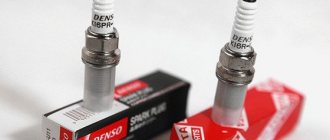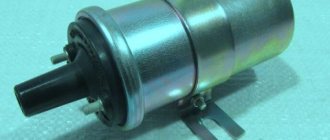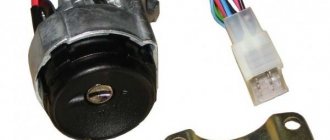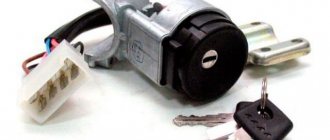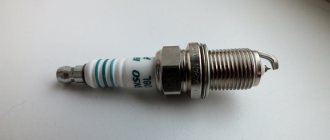I decided to change the spark plugs on the car. The choice fell on NGK V - line
.
I don’t know why, but when someone talks about candles, this is the name that comes to mind in my head) That’s why when I decided to change it, I immediately started asking about them. These candles are installed by many, proven ones. So I decided to install them for myself. Before this, the candles were installed BRISK
Quite good spark plugs. The car drove well. I don’t know how long it lasted. But the mileage is a bit much.
20 thousand
I think for sure) In the mornings it started to run rough. Especially at idle. Sometimes when you let off the gas it either started to work poorly or just stalled. I wasn’t very happy with it. It wasn’t very pleasant. As soon as I changed the spark plugs the car seemed to come to life) I’ve been driving for 2 days, but I don’t think about this problem anymore. I think the overclocking has become even better. It starts at the drop of a hat. They don’t give a damn when it’s warm or when it’s hot! It idles perfectly and the dip has disappeared. I still couldn’t get rid of it, but it turns out it’s the spark plugs) Below I copied the text from the topic about these candles. Read it, it might be useful. NGK NGK spark plugs can be easily distinguished from counterfeits by the direction of the electrode. In branded spark plugs from this manufacturer, the electrode is strictly perpendicular to the contact and has an even rod-like appearance; counterfeit spark plugs are distinguished by the uneven thickness of the electrode rod, as well as the curvature of its direction relative to the contact.
Differences between a fake candle and a real one: - Price. Too low a price should be alarming. — Printing quality. Real NGK has impeccable quality of inscriptions and drawings on the packaging (above). The fake one (below) has noticeable errors (the contours of the patterns of different colors are shifted relative to each other). As a result of improper assembly of the sides of the box, inscriptions and drawings may not be centered on the edges. — Central electrode. Take a closer look at it. If it does not have a clear cylindrical shape, is installed crookedly, or has minor defects, it is a fake. — Side electrode. Look at the candle from the side. A real spark plug's electrode is straight, but a fake spark plug's electrode is often crooked or has an oblique edge. — Party code. A real candle has a code on one of the faces of the hexagon indicating the party. The fake one does not have such a mark. - Carving. On a real candle, the thread is knurled, so it has an ideal surface. The fake candle has small chips visible on the edges of the thread. - Sealing ring. It is impossible to remove it on a real candle, but on a fake one you can twist it or even just remove it. — Isolator. For a real candle, the insulator is smooth (as if covered with glaze), but for a fake one it may be rough. A fake spark plug also often shows longitudinal protrusions remaining on the insulator after it is molded due to inaccurate joining of the mold halves. — The inscription on the insulator. For a real candle, it is smooth and neat. I bought it, came home and looked at it, it doesn’t look like a fake (probably a very high quality fake). Let's see how they turn out in practice)))
NGK spark plugs are currently one of the most common. They have mostly good reviews about their work on VAZ engines in recent years. There are standard NGK spark plugs, plugs with a V-shaped center electrode, plugs with a thin, high-strength iridium center electrode, plugs with a platinum center electrode, and plugs with multiple ground electrodes. Some types of NGK spark plugs are suitable for carburetor and injection engines of VAZ 2108, 2109, 21099 cars.
Selection of NGK spark plugs for VAZ 2108, 2109, 21099
NGK spark plugs are currently one of the most common. They have mostly good reviews about their work on VAZ engines in recent years. There are standard NGK spark plugs, plugs with a V-shaped center electrode, plugs with a thin, high-strength iridium center electrode, plugs with a platinum center electrode, and plugs with multiple ground electrodes. Some types of NGK spark plugs are suitable for carburetor and injection engines of VAZ 2108, 2109, 21099 cars.
Selection of NGK spark plugs for carburetor and injection engines of VAZ 2108, 2109, 21099 cars
First, we will select NGK spark plugs for carburetor 8-valve engines of VAZ 2108, 2109, 21099 cars with a contactless ignition system.
These are the following models: VAZ 2108, 2109, 21099 with a 1.1 liter carburetor engine (53 hp);
VAZ 2108, 2109, 21099 with a 1.3 liter carburetor engine (63 hp);
VAZ 2108, 2109, 21099 with a 1.5 liter carburetor engine (72 hp).
Let's see what general requirements apply to spark plugs for the engines of these cars.
The gap between the spark plug electrodes is 0.7 – 0.8 mm
Length of the threaded part – 19 mm
Thermal cone with a central electrode protrudes beyond the spark plug insulator
Presence of noise suppression resistor
List of NGK spark plugs meeting these conditions:
BPR6ES, code 7822
Copper central electrode, one side electrode, noise suppression resistor, gap between electrodes 0.8 mm.
BPR6E V-LINE No. 2, code 2268
Copper V-shaped center electrode, one side electrode, noise suppression resistor, 0.8mm electrode gap.
BPR6EIX, code 6637
Iridium central electrode, one side electrode, noise suppression resistor, gap - 0.8 mm.
BUR6ET V-LINE No. 1, code 2876
Nickel center electrode with V-shaped cutout, three side electrodes, noise suppression resistor, gap - 0.8 mm.
Now we will select NGK spark plugs for the 8-valve injection engine of VAZ 2108, 2109, 21099 cars. This is a VAZ 2111 engine with a distributed injection system. First, let's again look at the general requirements for spark plugs for this engine.
The gap between the spark plug electrodes is 0.9 - 1.1 mm
Length of the threaded part – 19 mm
Thermal cone with a central electrode protrudes beyond the spark plug insulator
List of NGK spark plugs that meet these conditions:
BPR6ES-11 code 4824
Central copper electrode, one side electrode, noise suppression resistor, gap between electrodes 1.1 mm.
BPR6ES-11 V-LINE No. 13, code 5339
A central copper electrode with a V-shaped cutout, one side electrode, an interference suppression resistor, the gap between the electrodes is 1.1 mm.
BPR6EIX-11, code 3903
Iridium central electrode, one side electrode, noise suppression resistor, gap between electrodes - 1.1 mm.
Notes and additions
— Standard spark plugs for 8-valve carburetor engines of VAZ 2108, 2109, 21099 cars - A17DVR, A17DVRM, A17DVRM1, for the injection 8-valve engine 2111 - A17DVRM.
Source
Advice on choosing candles and how to spot a fake
“Which plugs ?” It was not necessary, because only the internal one was on sale and the only model that was on the car. Now store shelves are filled with a huge selection of candles from all foreign manufacturers. This naturally gave impetus to scammers to falsify them, the price does not correspond to the quality, so pay attention to the following:
- In order not to succumb to counterfeiting, pay attention first to the packaging, the quality of printing from branded manufacturers is excellent, and for counterfeiting the contours of the drawings
- If packaging is not available at all, then further verification makes no sense; marking candles without packaging are not produced
- Next we'll look at the spark plugs themselves.
- Their central electrode must have an absolute cylindrical shape and the surface of the electrode must be smooth
- When there are defects on the electrode, or the electrode itself is installed crookedly. you know, this is a 100% fake
- In the case of a fake candle, the sides are crooked and have slanted faces. The thread of branded candles is produced using knurling, it is absolutely absolutely smooth
- The fake has small chips because it is produced by cutting
- O-ring cannot be removed from patented spark plug
- On a fake candle, this ring is either unscrewed with a thread or simply removed
- The insulator of the branded candle is shiny and absolutely smooth
- Counterfeits often show longitudinal seams due to inaccurately knitted shapes
- In addition, the inscription on the brand's spark plug insulator is always clear, smooth and precise
- And the last sign. real brand candles cannot be cheap
- Let the low price warn you
This is done with candles, see additional video.
Denso spark plugs for VAZ 2108, 2109, 21099 engines
Denso is a Japanese company that produces various components for cars of different brands. In particular, very good spark plugs for car engines. We will select spark plugs produced by Denso for the carburetor and injection engines of front-wheel drive VAZ 2108, 2109, 21099 cars.
General requirements for spark plugs for carburetor engines of VAZ 2108, 2109, 21099 cars (1.1, 1.3, 1.5 l engines) with a contactless ignition system
The gap between the spark plug electrodes is 0.7-0.8 mm
The length of the threaded part is 19 mm
Thermal cone with a central electrode protrudes beyond the spark plug insulator
Denso spark plugs meeting these conditions
W20EPR-U , index 3047 (D2)
Conventional single-electrode spark plug. Nickel central electrode. Interelectrode gap 0.8 mm. With noise suppression resistor. U-shaped notch on the electrode.
W20TT , index 4602(#4)
Single electrode spark plug. Interelectrode gap 0.8 mm. Nickel alloy central electrode. With noise suppression resistor. The manufacturer claims a longer service life of the spark plugs (30-40 thousand km) since it uses Twin Tip technology to improve spark formation - the central and side electrodes are reduced in diameter.
Denso iridium spark plugs with an interelectrode gap of 1.1 mm are also suitable for carburetor engines VAZ 2108, 2109, 21099.
IW20 , index 5306 (#4)
Single electrode spark plug. Iridium thin central electrode. Interelectrode gap 1.1 mm. Noise suppression resistor.
IW20TT , index 4709 (#4)
Single electrode spark plug. The central electrode is iridium, platinum (platinum needle). Interelectrode gap 1.0 mm. Twin Tip technology for improving spark generation has been applied. Noise suppression resistor.
General requirements for spark plugs for the injection 8-valve engine (2111) of VAZ 2108, 2109, 21099 cars
The gap between the spark plug electrodes is 1.0-1.1 mm
The length of the threaded part is 19 mm
Thermal cone with a central electrode protrudes beyond the spark plug insulator
Presence of noise suppression resistor
Denso spark plugs meeting these conditions
W20EPR-U11 , index 3049 (D13)
Single electrode spark plug. Nickel center electrode. Interelectrode gap 1.1 mm. Noise suppression resistor.
W20TT , index 4602(#4)
Single electrode spark plug. The interelectrode gap is 0.8 mm (despite the small gap, it is still recommended for the 2111 engine). Nickel alloy central electrode. With noise suppression resistor. The manufacturer claims a longer service life of the spark plugs (30-40 thousand km) since it uses Twin Tip technology to improve spark formation - the central and side electrodes are reduced in diameter.
IW20 , index 5306 (#4)
Single electrode spark plug. Iridium thin central electrode. Interelectrode gap 1.1 mm. Noise suppression resistor.
IW20TT , index 4709 (#4)
Single electrode spark plug. The central electrode is iridium, platinum (platinum needle). Interelectrode gap 1.0 mm. Twin Tip technology for improving spark generation has been applied. Noise suppression resistor.
Source
Checking and installing spark plug gaps in VAZ 2109 – 21099
Almost all spark plugs produced today have a factory-set gap between the electrodes. It is different for each manufacturer. It is also different for spark plugs for carburetor engines with contact and non-contact ignition systems, and for spark plugs for injection engines.
For example, the gaps between the electrodes of spark plugs for VAZ 2109 carburetor engines vary between 0.5-0.7 mm for a contact ignition system, 0.7-0.9 mm for a non-contact ignition system.
Moreover, it is recommended to make the gap smaller by 1 mm in winter, and larger by 1 mm in summer. In this way, improved engine starting and stability of its operation at different atmospheric temperatures are achieved.
It is believed that prolonged cranking of the engine with the starter at low ambient temperatures can discharge even a new battery so much that its voltage is not enough to form a spark if the gap between the electrodes is too large or normal. At the same time, increasing the gap creates additional load on the ignition coil.
For VAZ 2109 injection engines, the gap is in the range of 0.9-1.1 mm. There are no recommendations for changing the gap size for different seasons.
“Hot” and “cold” or what is the heat rating
What you need to know about the marking of spark plugs and which ones to put on a VAZ-2107 For classic VAZ models with contact ignition
For models with contactless protection
How to choose high-voltage wires
A mistake in choosing spark plugs can “kill” the engine. Spark plugs can affect fuel consumption. There are “incompatible” spark plugs and high-voltage wires. In this article, we'll look at what you really need to know and consider if you service your car yourself. After all, this small device, which looks so simple, is in fact a complex and high-tech product with strictly adjusted dimensions, made from materials specially designed for candles.
Troubleshooting
Systematic checking of spark plugs with your own hands allows you to get rid of a lot of problems and financial expenses, as well as give the car the opportunity to demonstrate its full potential on the track:
- It is important to detect and replace a faulty spark plug as quickly as possible.
- Based on the carbon deposits formed on it, you can easily diagnose the operation of the engine and ignition system components
- A typical cause of spark plug malfunction is incorrect selection when replacing
- Despite the fact that all car manufacturers literally shout: “Use only spark plugs recommended for this vehicle, or acceptable analogues”
- However, sometimes our own laziness gets in the way, and sometimes we don’t have the opportunity to purchase the right candle
- Therefore, we often establish what will turn up on a car
- We often justify such actions by saying that we don’t understand anything about replacing spark plugs.
- And you just need to choose and buy new ones in the image and likeness of the previous ones, and with the cooled engine turned off, unscrew the spark plugs using a special key, and then screw in new ones
- The main thing to remember is that new spark plugs must perfectly match all the geometric and thermal characteristics of the previous spark plugs installed by the factory
- Otherwise there will be problems
- If the heat value is insufficient (the so-called degree of thermal conductivity), the owner will face immediate problems with the operation of the engine and the entire ignition system
- And if the spark plug has a mismatch in the geometric dimensions of the threaded part (shorter than it was or longer), then it will either become clogged with carbon deposits or filled with gasoline and naturally work poorly
- Advice to those who do not like to tinker with equipment often, you just need to follow one simple rule to avoid problems with the engine:
- It is only necessary to change the spark plugs every 30 thousand kilometers.
- Check and clean every 5 thousand kilometers
- It turns out that to prevent faulty spark plugs from causing problems, you need to remove carbon deposits from the spark plugs 10 times (within two years with constant driving).
Checking the gap between the spark plug electrodes
When installing new spark plugs on an engine or checking old ones, it is necessary to measure the gap between their electrodes. Old spark plugs should be cleaned of carbon deposits. The check is carried out with a round probe of the required diameter.
When checking and replacing spark plugs, be careful - if the engine is hot, you can get burned.
Measuring with a flat probe will be inaccurate, since there is almost always a small indentation on the side electrode of the spark plug due to metal transfer to the central electrode. This is especially true for candles that have already worked for some time.
Which parts to choose?
When choosing spark plugs for a VAZ 2106 car, you must be guided by the numerical value indicated on the marking. It denotes the heat value of the element, which characterizes the candle’s ability to remove heat and self-clean from carbon deposits during operation. According to the Russian classification, elements are divided into the following groups:
- Heat number from 11 to 16 are “hot” candles. They are designed for engines with low compression ratios and low power.
- The same, from 17 to 19. The most widely used spark plugs, including on VAZ 2101-07 cars.
- The same, from 20 to 26, “cold” spark plugs are installed on powerful engines with a high compression ratio and temperature in the combustion chamber.
If you install too “hot” or “cold” spark plugs on a VAZ 2106 car, the engine will not be able to function in normal mode with maximum efficiency. The letter indices on the marking indicate less important parameters, but they also need to be taken into account. For example, a product with the designation A17DV is suitable for engines with a carburetor and an ignition system with mechanical contacts, and A17DVRM for power units with an injector.
The trouble is that the classification of imported candles differs from Russian ones, and there is no single measurement system; each manufacturer has its own. Therefore, before you buy reliable products from the Japanese company NGK or another brand for the VAZ 2106, it is recommended to study the table.
LADA spark plugs: top 10 options
The rating contains 10 modifications of spark plugs, without division into specific car models.
10th place: ZZ A17 DVRM
The list of the best offers opens with an effective model that is in demand among a large number of buyers. Such prevalence is ensured by the stable quality of products. In the original packaging it is impossible to find a defective part or a spark plug with a broken gap. A significant advantage of the products is the ability to work actively even when the voltage drops to 6V in the on-board network. Similar spark plugs in the VAZ 2107 are often found due to their moderate cost.
The indicators are overshadowed by bad statistics - as of 2020, 35% of the kits on the market are fakes, which forces motorists to carefully select products in stores.
- reasonable price;
- durable;
- simple design.
Reasons for replacing elements
The spark plug in any car must function in difficult conditions, solving the following problems:
- promptly ignite the air-fuel mixture compressed in the cylinder;
- provide an even and powerful spark discharge on its contacts;
- sparking should not deteriorate under any engine operating mode.
For ignorant car enthusiasts, checking spark plugs comes down to a “spark” test. This gives rise to an erroneous statement: if, when connected to a source, a spark jumps between the contacts, then the element is in good working order.
But the conditions inside the combustion chamber differ from normal atmospheric ones, since there is high pressure (over 10 Bar), and instead of air there is fuel plus high temperature. Often, a spark plug that produces a reliable spark discharge in air, in the cylinder, works with misfires or does not spark at all.
Notes and additions
— For spark plugs for carburetor engines with a contact ignition system for VAZ 2101, 2102, 2103, 2104, 2105, 2106, 2107 cars, the recommended gap between the electrodes of the spark plugs is 0.5-0.7 mm, for VAZ 2108, 2109, 21099, 2105, 2107 with a contactless ignition system 0.7-0.9 mm.
For injection engines of VAZ 2107, 2108, 2109, 21099 cars 1.0-1.1 mm.
An incorrectly set gap between the electrodes of the spark plugs leads to problems with starting the engine, unstable engine idle speed, jerking when starting and driving, “dips,” loss of power and throttle response, and an increase in the engine’s fuel appetite. Normal engine operation can only be ensured by a spark plug with a gap specific for a given engine type.
Regularly check the reliability of the connections of the high-voltage wires with the spark plugs, coil and ignition distributor.
With a smaller gap, the spark will be short and weak, combustion of the fuel mixture worsens, with a large gap, the voltage required to break through the air gap between the electrodes of the spark plug increases. In this case, there may be no spark at all.
There is no need to set the gap on multi-electrode spark plugs.
How do candles work?
To understand what is happening and why, we need to understand the nature of the phenomenon occurring, and the roots of the phenomenon are hidden deep under the hood:
- The chain reaction that leads to the VAZ 21093 i flooding the spark plugs begins when you just turn the key in the ignition
- When a combustible fuel-air mixture is supplied to the combustion chamber, which consists of a mixture of gasoline and air that entered this chamber through the intake valves. These valves were brought into operation by the starter. Everything is clear here for now
- The spark plug at this point in time provides an ignition spark, which “comes” through the high-voltage wires from the ignition coil
- Then the mixture of fuel and air ignites from a spark, and a small micro-explosion occurs, after which the engine starts, valves and pistons, and all other mechanisms begin to move
Scheme for detecting problems in the ignition system based on the state of the spark plugs
So that you can independently identify faults in the ignition system, the photo above shows a table. So:
- As you understand, the most important elements in this chain of interactions are the spark and the combustible mixture of fuel and air
- Therefore, if there is no spark for some reason, the motor simply does not work.
- Therefore, after a few minutes of rotating the engine with the starter, the spark plug is filled with unburnt fuel, causing it to get wet.
- It turns out that the VAZ 21093 floods the spark plugs and there will be no normal spark, and without a spark there is no ignition
- You should be aware that in damp autumn or cold winter weather, ignition of the combustible mixture of air and fuel may not occur, even with fully working spark plugs
- Simply, when the temperature of the surrounding atmosphere (environment) drops below 15 degrees, the mixture of fuel and air is cooled to such a limit that ignition problems begin to arise
- In addition, problems arise with the spark; the spark plug does not work in normal mode, but in high load mode
- If the engine does not start immediately, the owner stubbornly continues to rotate the engine with the starter
- Then the VAZ 21093 gets flooded with spark plugs (like any other car), and they stop functioning completely
Checking and replacing spark plugs VAZ-2109
You will need: a spark plug wrench, a round dipstick.
Replacement frequency: After 30,000 km.
Before starting work:
Disconnect the wire from the “─” terminal of the battery.
Spark plug type: A17DVR, A17DVRM, FE65PR, FE65CPR. Until 1988, spark plugs of types A17DV and FE65P were installed on the VAZ-2109.
We recommend replacing spark plugs every 30,000 km, even if they are still in working order: old spark plugs can increase fuel consumption.
Prevention
- To avoid replacing spark plugs frequently, watch what you put into the tank and avoid “left-handed” gas stations.
- Check the condition of the spark plugs regularly, for example, every 5 thousand km. This will save you from excessive fuel consumption and unpleasant surprises on the road, especially in winter.
- Buy a set of spark plugs and carry them with you, as they say, just in case.
- Monitor the engine oil level and condition.
- Buy only high-quality spark plugs, preferably those recommended by the manufacturer of your car, but this does not mean that others are contraindicated for you. You have the right to choose similar spark plugs, the main thing is that they match the parameters (operating temperature, heat rating, number of side electrodes, thread diameter, etc.). Leading manufacturers of spark plugs: NGK, BOSCH, Brisk, DENSO.
I have everything, I hope you will draw the right conclusions. Those who liked the article can express their gratitude in the comments. Those who didn't like it can also express disagreement. If you think that the article is incomplete, please feel free to supplement me, again using the comment form. Bye everyone, see you again at VAZ Repair. Take care of yourself and your VAZ!
Source
